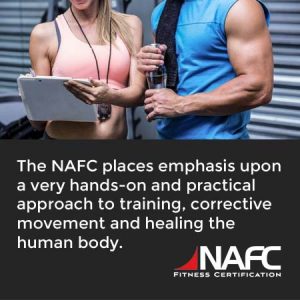Level 1: Fitness Trainer Certification Information

Prerequisites:
- Minimum GED or High School Diploma required.
- You must be 18 years of age or older.
-
You must have and maintain a CPR/AED certification.
Course Education Level: Beginner
Continuing Education Credits: 0.5 IACET 0.5 NAFC
How it Works:
To earn this certification…
- Review all course material
- You must take and pass your
certification written examination with a passing score of 75% or higher -
You have 90 days to complete and meet all requirements for your certification.
 Certification Process:
Certification Process:
- Your NAFC Level 1 Fitness Trainer certification is valid for 24 months. During those 24 months you must complete continuing education prior to your renewal date to qualify for re-certification.
- Recertification is required to keep you up to date with industry standards and practice. You must complete and submit 15 hours (1.5 NAFC credits) of continuing education in a 24 month period of time prior to your renewal date and complete a re-certification application to be recertified.
Click Here for System Requirements to View and Complete this Course.

Thinking about a career in the fitness industry? The Level 1 Fitness Trainer Certification prepares you for several entry level jobs in the fitness industry. This 10-12 hour certification provides you with a sound base of information and skills needed to qualify for several entry level jobs in the fitness industry at a reasonable cost and time investment.
Level 1: Fitness Trainer Certification Course Materials include:
- Introductory document with certification completion steps.
- Interactive online Foundations of Fitness and Exercise course. (Estimated completion time 5 hours)
- Level 1 Fitness Trainer PDF Manual (Estimated completion time 3 hours)
- Practice Exam
- Certification Exam
(PDF Manual can be viewed on a computer or tablet and can be printed for reading.)
Level 1 Foundations of Fitness and Exercise (Online Course)
After completing this course, you will be able to:
- Identify 8 cardiovascular risk factors and their relationship to health.
- Describe lifestyle disease, preventive medicine, and the concept of exercise as medicine.
- Describe the 5 components of fitness and the role genetics plays in exercise.
- Identify 5 organ systems and major bones, joints, and muscles and their properties in the human body.
- Identify 9 anatomical reference and 12 anatomical movement terms to describe human movement.
- Describe the role of levers and planes of motion in human movement.
- Discuss 6 principles of exercise training.
- Describe how the 3 energy systems work in the body.
- Describe agonist/antagonist muscle action in gravity for 12 movements.
- Describe body alignment and the 5 parts of the NAFC ANSER™ acronym.
Level 1 Fitness Trainer (PDF Manual)
After completing this course, you will be able to:
- Recognize 8 factors that affect your role as a fitness trainer.
- Discuss the difference between physical activity and exercise.
- Identify proper facility and exercise etiquette.
- Explain the difference between the health-related components of fitness and the skill-related components of fitness.
- Discuss how to practice within legal boundaries as a Fitness Trainer professional.
- Explain the difference and requirements of five basic types of training.
- Identify equipment for cardiorespiratory training, resistance training, and flexibility training.
- Recognize three types of instructional/motivational techniques.
- Explain basic general nutritional needs/recommendations/eating strategies and identify 7 essential nutrients that fuel the body.
- Identify the 6 steps taken to onboard new clients.
- Describe basic assessment for 5 components of fitness.
- Identify 8 factors that contribute to safety in exercise.
- Recognize 5 common injuries in exercise and use of the R.I.C.E. method for treating injuries.
- Explain proper form and technique for 15 flexibility exercises.
- Explain proper form and technique for 25 resistance training exercises.

